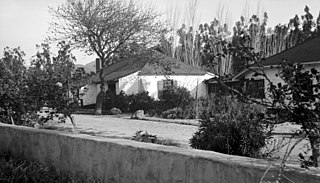
Rancho Camulos, now known as Rancho Camulos Museum, is a ranch located in the Santa Clara River Valley 2.2 miles (3.5 km) east of Piru, California and just north of the Santa Clara River, in Ventura County, California. It was the home of Ygnacio del Valle, a Californio alcalde of the Pueblo de Los Angeles in the 19th century and later elected member of the California State Assembly. The ranch was known as the Home of Ramona because it was widely believed to have been the setting of the popular 1884 novel Ramona by Helen Hunt Jackson. The novel helped to raise awareness about the Californio lifestyle and romanticized "the mission and rancho era of California history."
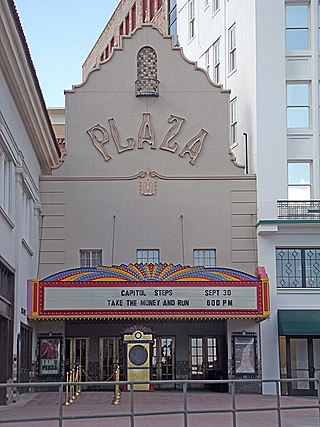
The Plaza Theatre is a historic building in El Paso, Texas built in 1930. The theater stands as one of the city's most well-known landmarks, and remains operational today. The theatre is a National Historic Building of Significance featuring the 2,050-seat Kendall Kidd Performance Hall, and the smaller 200-seat Philanthropy Theatre. It hosts Broadway productions, musical concerts, individual performers and the annual Plaza Classic Film Festival.

The Hotel Bovill is a former hotel in Bovill, Latah County, Idaho, United States. It was constructed in 1903 by Hugh Bovill, an English settler and son of Sir William Bovill, Chief Justice of the Common Pleas. Hugh and his wife, Charlotte, operated the house as a hotel from 1903 to 1911, serving tourists and loggers. In addition to lodging, the hotel also housed a store, and was a hub for local commerce in the community.

The Chick House is a former hotel building constructed in 1857 in the city of Rockford, Illinois, United States. The building's construction was financed by three Rockford citizens and it operated as a hotel from its opening until 1951. The hotel was purchased by Thomas Chick in 1888 and he renamed it from the Griggs House to the Chick House. In 2004 the city of Rockford purchased two-thirds of the building and made some modifications to the structure. The building is a mesh between the Greek Revival and Italianate styles and feature simple ornamentation that contrasts with a neighboring building. The Chick House is a Rockford Landmark and was listed on the U.S. National Register of Historic Places in 1997.

The Battle House Renaissance Mobile Hotel & Spa, is a historic hotel in Mobile, Alabama. The current structure was built in 1908 as the Battle House Hotel. It is the second hotel by that name to stand in this location, replacing an earlier Battle House built in 1852, which burned down in 1905. It is one of the earliest steel frame structures in Alabama.
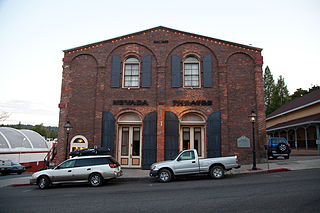
The Nevada Theatre, also known as the Cedar Theatre, located in downtown Nevada City, California, is California's oldest existing theater building. Its principal periods of significance were 1850–1874, 1875–1899, 1900–1924, and 1925–1949.

The Monroe Avenue Commercial Buildings, also known as the Monroe Block, is a historic district located along a block-and-a-half stretch at 16-118 Monroe Avenue in Detroit, Michigan, just off Woodward Avenue at the northern end of Campus Martius. The district was designated a Michigan State Historic Site in 1974 and listed on the National Register of Historic Places in 1975. The thirteen original buildings were built between 1852 and 1911 and ranged from two to five stories in height. The National Theatre, built in 1911, is the oldest surviving theatre in Detroit, a part of the city's original theatre district of the late 19th century, and the sole surviving structure from the original Monroe Avenue Commercial Buildings historic period.

The Dearborn Inn, A Marriott Hotel is a historic hotel in the suburban city of Dearborn, Michigan in Metro Detroit. It opened in 1931 and closed in February 2023 for renovations. It was conceived by Henry Ford, who saw a need for food and accommodations for visitors flying into the nearby Ford Airport, making it one of the first airport hotels. It is located at 20301 Oakwood Boulevard near The Henry Ford and the world headquarters building of Ford Motor Company. Albert Kahn designed the Dearborn Inn in the Georgian architectural style. The Dearborn Inn is owned by Ford Motor Land Development Corporation and managed by Marriott International.

Hotel Blessing is a historic hotel located in Blessing, Texas, United States. The hotel was designed by Jules Leffland of Victoria. The hotel has been a community gathering place since it opened in 1907 The building was added to the National Register of Historic Places on February 1, 1979.
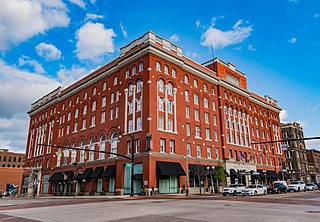
The Great Southern Hotel & Theatre is an historic hotel and theater building in Downtown Columbus, Ohio. The building currently operates as the Westin Great Southern Columbus and the Southern Theatre.

The Mountain View Grand Resort & Spa – formerly called the Mountain View House – is an historic grand hotel at 101 Mountain View Road in Whitefield, New Hampshire, United States, with claims to dating back to 1865.

The Savoy Hotel and Grill was a historic hotel and restaurant in Kansas City, Missouri. The Savoy Hotel was the oldest continuously operating hotel in the United States west of the Mississippi River until it closed in 2016 to undergo extensive renovation by 21c Museum Hotels and reopened in 2018. In 1974 it was listed on the National Register of Historic Places as "Savoy Hotel and Grill". It is now called "21c Museum Hotel Kansas City".

The Mississippi Lofts and Adler Theatre is an apartment building and theater complex located in downtown Davenport, Iowa, United States. It is individually listed on the National Register of Historic Places by its original name, the Hotel Mississippi and RKO Orpheum Theater. The Hotel Mississippi was listed on the Davenport Register of Historic Properties in 2005. In 2020 the complex was included as a contributing property in the Davenport Downtown Commercial Historic District.
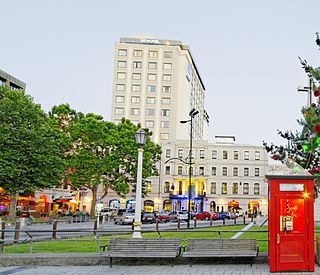
Warner's Hotel in 50 Cathedral Square, Christchurch is the site of a hotel established in 1863. The original building, extended on numerous occasions, burned down in 1900. A new building was built in 1901. Again, it underwent numerous alterations. A fourth storey was added in 1910 and the northern end of the building was demolished in 1917 and a theatre built in its place to create a noise buffer to the printing presses of the adjoining Lyttelton Times Building. The theatre was demolished in 1996 and patrons enjoyed a beer garden. In 2010, a high-rise Novotel hotel opened on the site of the beer garden and in the process, the historical and symmetrical 1901 façade was recreated.

Peter Josiah Barber was an American carpenter, architect, and prominent citizen of Santa Barbara, California. A native of Ohio, he was drawn to California during the Gold Rush in 1852 and settled in Santa Barbara in 1869, where he established himself as the city's foremost architect and served as postmaster and for two terms as mayor. His works include the Arlington Hotel, the second County Courthouse, and the original Santa Barbara Cottage Hospital, as well as several private houses. As mayor, he was also responsible for public works projects, most prominently the tree-lined boulevard, now called Cabrillo Boulevard, at East Beach. Three of the buildings he designed are listed on the National Register of Historic Places.

The Hotel Washington is a historic hotel located at 515 15th Street NW in downtown Washington, D.C.

The Hotel Virginia was built in 1925. It was listed on the National Register of Historic Places in 2000. It is also designated by the city of Santa Barbara as a local historical landmark. The building is located on the southern side of West Haley Street, 17 W. Haley Street, in the southeastern part of the historical center of Santa Barbara, California.

West Chester, also known as the D.S. Chamberlain House and Wesley Acres, is a historic building located in Des Moines, Iowa, United States. Designed by Boston architect William George Rantoul, it is considered an excellent example of Jacobethan Revival architecture in the city. It was featured in a couple of publications after its completion. The inspiration for the house's design were the half timbered homes in Chester, England. It features five gables and dormers on the main facade that rise above the ridged roofline and three tall chimneys with separate shafts for each flue. There are two gabled wings on the south elevation of the house.

The Castañeda Hotel is a historic railroad hotel located in Las Vegas, New Mexico. It was built in 1898 and 1899 by the Atchison, Topeka and Santa Fe Railway, and was operated by the Fred Harvey Company until 1948. After being mostly vacant for many years, the hotel was restored and reopened in 2019. The Castañeda was listed on the New Mexico State Register of Cultural Properties in 1974 and the National Register of Historic Places in 1979 as a contributing property in the Railroad Avenue Historic District. It is located adjacent to the Las Vegas railroad station.





















